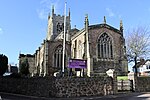Cossington Meadows
Leicestershire and Rutland Wildlife Trust

Cossington Meadows is an 88.9 hectares (220 acres) nature reserve west of Cossington in Leicestershire. It is managed by the Leicestershire and Rutland Wildlife Trust.Flora on this wetland site include flowering rush, purple loosestrife and blue water-speedwell. There are several pools which attract wildfowl, such as gadwall and tufted duck, which breed on the site.There is access from Syston Road.
Excerpt from the Wikipedia article Cossington Meadows (License: CC BY-SA 3.0, Authors, Images).Cossington Meadows
Syston Road, Charnwood
Geographical coordinates (GPS) Address Nearby Places Show on map
Geographical coordinates (GPS)
| Latitude | Longitude |
|---|---|
| N 52.711 ° | E -1.118 ° |
Address
Syston Road
Syston Road
LE7 4UY Charnwood
England, United Kingdom
Open on Google Maps








